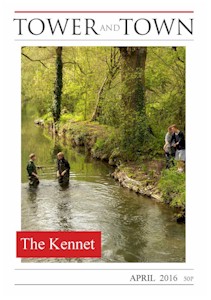

Tower and Town, April 2016 (view the full edition) (view the full edition)Industry And The KennetThe Industrial History of the River Kennet and Marlborough. The River Kennet has played an influential part in the history of Marlborough’s industry. At the heart of the historical development of the town of Marlborough was the tanning industry. Tanning is how animal hides are converted into leather. Its name originates from the tannic acid used in the process. Tanning is an ancient process which originated in around 2500 BC. The first tannery in Marlborough opened around 1350, and by 1379 Marlborough had ten tanners. Sheepskins and wood found in the Savernake Forest, combined with water provided by the River Kennet, meant that the town was an ideal location for tanning. As a result of this Marlborough’s tanning industry flourished throughout the 14th century. Tanning was one of the major industries whose success was directly related to the River Kennet. However after a fire which started in one of the major tanneries there was a decline in the number of tanners in Marlborough. The fire engulfed both sides of the High Street up to St. Mary’s Church. It burnt down 244 houses and led to the rebuilding of the High Street as we know it today. Along the River Kennet there are still the remains of many aspects of industry - notably other mills. It was clear that the water provided by the Kennet was a huge part of the success and growth of the town. Not only did it provide the power needed but it was part of the transport link between Bristol and London. The Kennet and Avon canal, running parallel with and close to the Kennet, was created in 1810 and made a huge impact on those trading goods in the area. It provided a fast means of transport and trade in the area flourished. Throughout its time the Kennet has undergone many changes, of which many have been to do with the success of the industry. One area where the river was built up was for a fulling mill which was built in 1215, an early period of time for such a mill. The mill was part of a process for cleaning wool and cloth. We can still see the remains of this at the Old Town Mill. Marlborough’s history is inextricably linked to the river that runs through it. The industries may have changed and moved on but their legacy can be seen in the very structure of the famous High Street that follows the route of the Kennet and in the whole construction of the town. Hannah Wilson |